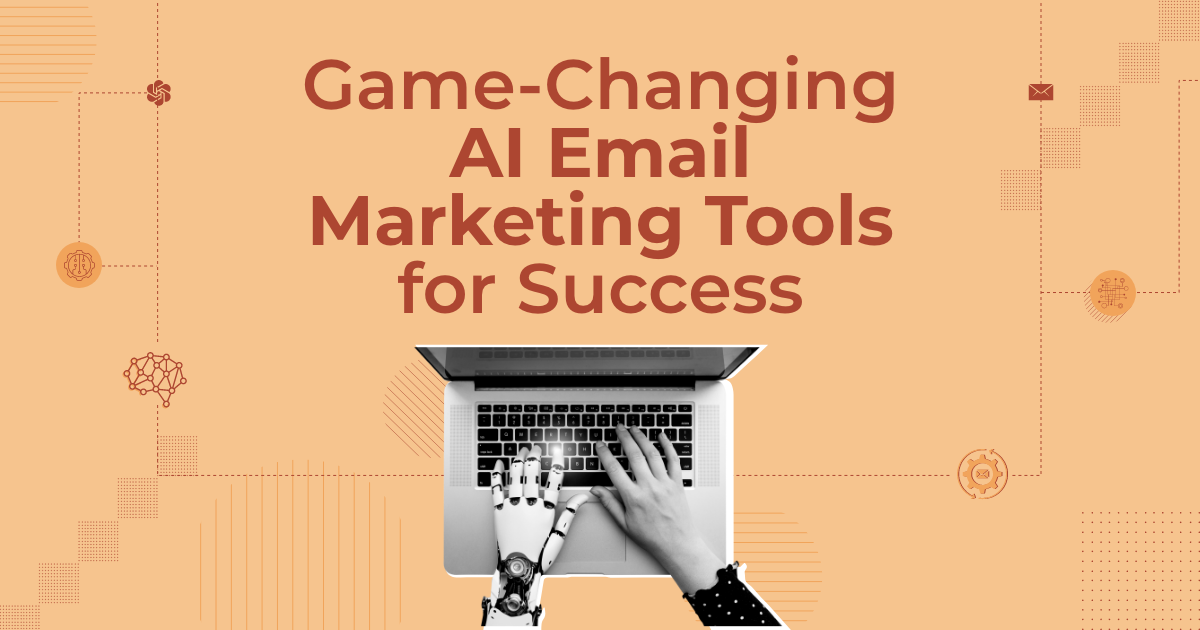
Sustainable Email Marketing: Best Practices And Examples [2025]
Emails are supposed to be the eco-friendly alternative to paper. Even though their environmental impact is lower, there’s still room for improvement. Consider how much data storage, internet usage, and energy consumption are needed to send, receive, and store emails.
Rapid climate change calls for more sustainable business practices and consumer habits. While zeroing carbon emissions is probably unrealistic, there are many eco-friendly tactics to reduce it.
Adopt a sustainable email marketing strategy–or enhance your existing one–following the best practices below. Plus, explore how eco-conscious businesses share their green initiatives via email to attract and engage their target audience.
Make eco-friendlier email marketing choices
Clean your lists and send your campaigns mindfully with Moosend.
Start freeWhat Is Sustainable Email Marketing?
Sustainable email marketing is the process of refining your email marketing strategy to reduce the carbon footprint of your emails. Businesses achieve that following sustainable practices, such as compressing file sizes and segmenting email lists.
Those initiatives don’t only lead to eco-friendlier email marketing, but more efficient and meaningful, too. Sustainability brings more consciousness to promotional and outreach tactics by choosing personalized emails over blast ones. So fewer emails and less energy can lead to higher conversions and better results.
Sustainable Marketing Stats
Let’s talk numbers for a while to get a better grasp of why sustainability should become a priority. First, internet usage and all systems that contribute to it, from devices to data centers handle 3.7% of global emissions annually.
According to Mike Berners-Lee’s book, “How Bad are Bananas”, BBC reported that a single email can exert 4g of CO2 while one with a heavy attachment 50g CO2–if not more.
Here are some interesting sustainable marketing stats:
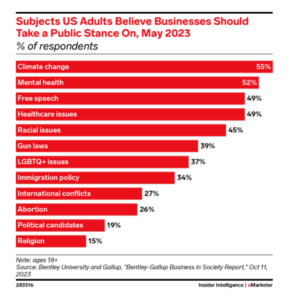
- 55% of adults believe that businesses should share a clear public opinion about climate change.
- 64% of marketers expect to put more focus on social impact and environmental sustainability.
- However, only 18% of senior marketers put sustainability as a priority.
Even though consumers expect businesses to talk openly about climate change and many marketers are willing to put sustainability high on the agenda, there’s still some resistance on the business side. However, in the next few years, this reluctance will most likely be stopped by stricter policies and more determined consumers.
How To Make Your Email Marketing Eco-Friendlier
Let’s explore how to make your email marketing practices more eco-conscious:
1. Conduct regular email list cleaning
A “tidy” email list is not only the path to a higher deliverability rate, but an eco-friendlier marketing approach, too–a win-win scenario. Clean your email lists regularly, removing inactive, invalid, and bounced email addresses to improve your metrics and consume less energy, as well.
Revisiting your opt-out process is also vital. For example, add an unsubscribe link on your email footer or send an email to inactive subscribers and give them the chance to opt in again before removing them from your lists.
If you have a large subscriber base, integrate your email marketing service with list management software to save time and meet your goals faster, with more accuracy.
2. Create more targeted email campaigns
Email segmentation is one of the most popular and profitable email marketing techniques, and it turns out that it’s one of the most sustainable, too. Divide your lists into different sub-groups based on shared characteristics, such as demographics.
An email marketing platform will give you access to data about customers and prospects, such as browsing history and previous purchases. This way, you’ll be able to send more targeted content and product recommendations. You can also collect valuable information about subscribers through well-crafted preference centers.
For instance, you’ll get higher open rates when you send abandoned cart emails to prospects who expressed a real interest in a product. Likewise, preference centers will help you gather important information about customers and send them more relevant content.
When you make data-driven and personalized choices instead of sending promotional emails in bulk, you decrease your carbon footprint and increase your deliverability and credibility as a brand.
Many email marketing platforms like Moosend help you manage most of personalization processes. Kick off your sustainable campaign practices with user-friendly features–including automation and segmentation.
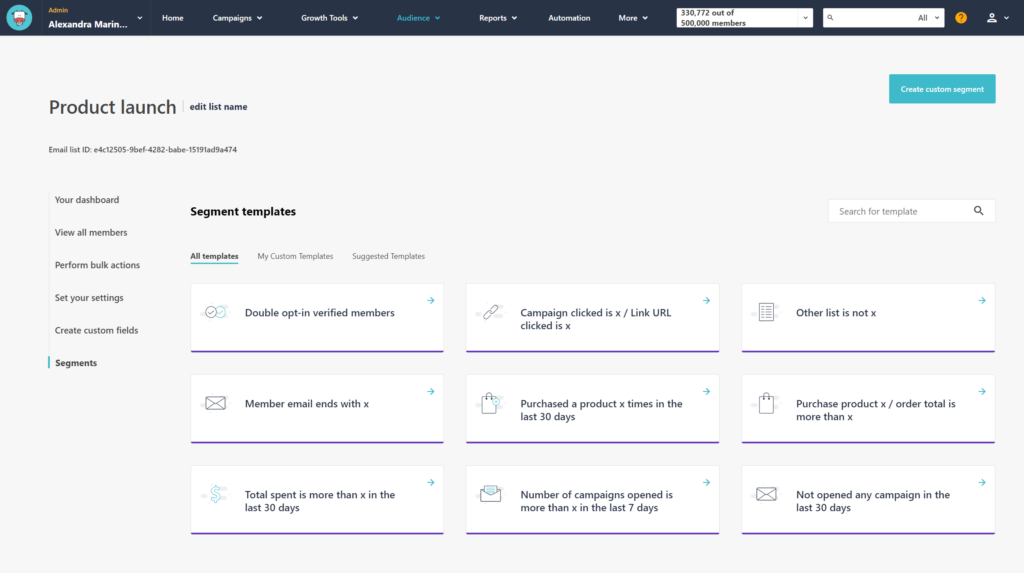
3. Adapt your email sending frequency
How many emails do you send per month? Each business has different sending habits based on their email marketing strategy. However, sending three email campaigns weekly is not only spammy, but wasteful, too.
Sustainable email marketing calls for more mindful email sending decisions to reduce carbon emissions. Send between four to eight emails per month and consider A/B testing your campaigns to find the best sending time and maximize your performance.
If you create automation workflows, find the silver lining of the subsequent emails you set up to perfect user experience and make a positive impact on our planet simultaneously.
4. Build more compact email campaigns
Emails with large files and attachments consume more energy and lead to higher greenhouse gas emissions compared to simpler versions. So, instead of sending those emails in bulk, save them for when it’s necessary.
This doesn’t mean you should only send plain text emails from now on. Compress your file sizes and images and stick to simpler email templates to save data storage and reduce loading time.
Apart from helping the environment, you’re highly likely to improve your email performance, too. Email recipients usually spend a few seconds per email, so the more skimmable they are, the easier it will be to clearly transfer your messages to them.
5. Educate your audience on eco-friendlier actions
To create a strong sustainable community, get your customers and partners on board by sharing easy green practices with them. For example, many professionals and businesses use green statements in email signatures and footers, such as “Think before you print.”
Many marketers also launch awareness campaigns on Earth Day or similar occasions to start a constructive dialogue around those matters. You can focus on different environmental issues based on your products/services and the industry you’re in.
In this campaign, Wonder Valley shared an interesting resource on how olive trees can contribute to reducing greenhouse gas levels, followed by a set of olive-made products:
Subject line: Olive Trees & Climate Change

6. Share your environmental actions and certifications
Consumers seek evidence from brands about their sustainability programs and credibility. From B corporation to vegan certifications, add relevant badges or information inside your emails to help subscribers rest assured that you’re committed to a worthy cause.
Many businesses also include their mission statements to attract like-minded consumers, mentioning what they stand for. You can also share blog posts or visuals of your latest actions to inspire your readers.
7 Best Sustainable Email Marketing Campaigns
Have a look at seven amazing campaign examples with eco-friendly messaging and learn why they grabbed our attention:
1. Bite’s ecological impact email campaign
Subject line: Save 40%. Go plastic-free. Win-win.
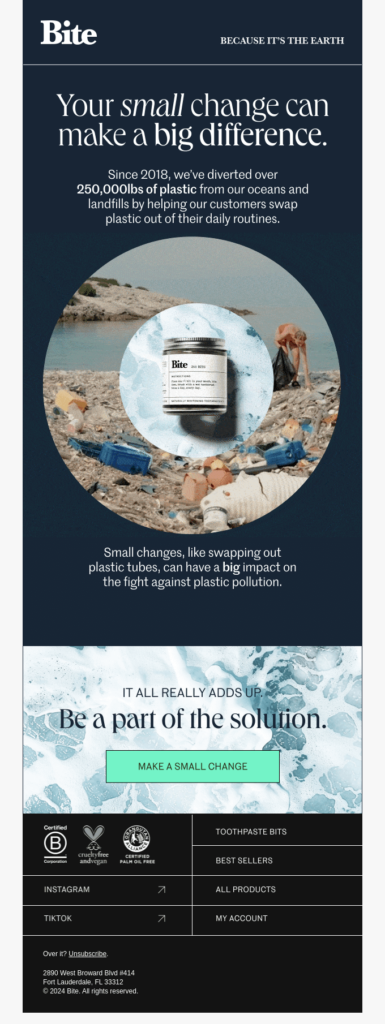
Bite is a toothpaste business thar offers plastic-free products with no chemicals. In this campaign, they explain what they’ve achieved through the years to save the planet.
Through a compelling visual and impactful copy showing the real problem, this email has everything a self-conscious consumer needs to feel trust in a brand.
Why it works:
- The subject line includes attractive elements and words, such as win-win, including a statistic to grab readers’ attention.
- The email copy is simple yet powerful, providing evidence of why slight changes can have a significant impact on reducing plastic pollution.
- They added a call-to-action button with the copy “Make a small change” to invite readers to click-through.
2. Happy Human’s holiday email
Subject line: It is possible to do Christmas Consciously? 🎄

Happy Human provides home and personal care products with eco-friendly packaging that invests in educating their audience on more sustainable practices.
This amazing Christmas email campaign includes tips for minimizing the extra holiday waste and two more incentives for customers.
Why it works:
- The subject line perfectly describes the topic of the campaign, including a Christmassy emoji to make it more appealing.
- They added a resource from their blog to educate their audience with clever copy that steals the show.
- They included their referral program to bring more conscious consumers to enter the competition for one year supply or refills.
3. Xfinity’s Earth Day email campaign
Subject line: Let’s make Earth Day every day
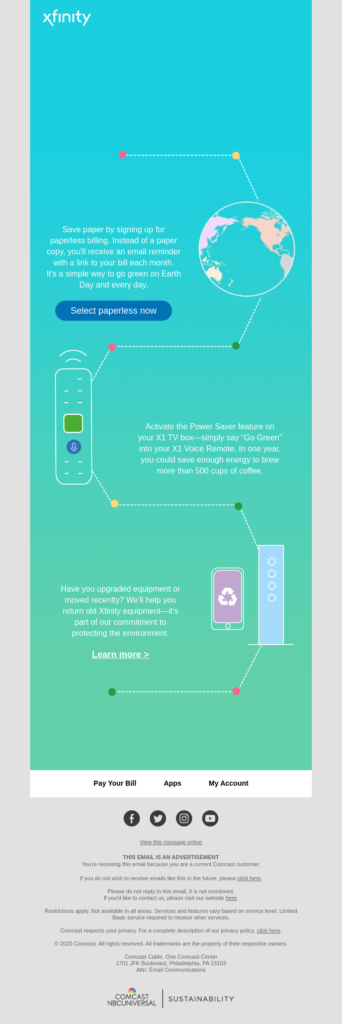
Xfinity is a telecommunications business that sent an Earth Day email campaign to show customers and prospects how their services can lead to more sustainable living.
If you also offer eco-friendly solutions, remind your customers about them on this special day.
Why it works:
- It has a simple infographic with visuals and copy that match perfectly the services they portray.
- The call to action copy–”Select paperless now”–creates a sense of urgency.
- They explain the benefits of each service to make readers grasp how they’ll help the planet by activating them.
4. Made Trade’s sales campaign
Subject line: Save on our sustainable best sellers 🌟

Made Trade is another sustainable and ethical brand that created a sales campaign offering 10% off for their best-sellers.
The copy is sprinkled with words that emphasize sustainability and quality for like-minded consumers.
Why it works:
- They added the incentive and discount code at the top to help readers spot them easily.
- They posted customer testimonials to entice prospects to claim the best-sellers fast.
- The company mission and certifications add to the sustainable identity of the business.
5. ETON’s sustainability survey email
Subject line: Take part in our sustainability survey
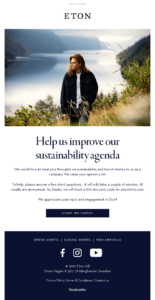
If you want to power up your sustainability efforts, build a survey email as ETON did, asking your customers’ feedback.
This way, you’ll make your audience feel part of a greater purpose, showing that their opinion matters to you.
Why it works:
- They created a simple email outline with a powerful image and a unique CTA button.
- They shared a discount to incentivize more people to take part in the survey.
- They highlighted how long the survey will take, and that participation is anonymous.
6. Outer’s launching email campaign
Subject line: We’re Saving the Planet, One Tree at a Time

Outer is a premium outdoor furniture business with sustainability high on their agenda. For the launch of their new collection, they partnered with One Tree Planted to reinforce reforestation in Indonesia.
Join similar initiatives and take an active stand on crucial environmental issues, explaining the reasoning behind them.
Why it works:
- They announced how much of their income they’ll donate to the organization they partnered with.
- They added a CTA link for readers who want to learn about their sustainable practices.
- The visuals enhance the messaging, displaying the new collection and the initiative they’ll support.
7. Rareform’s browse abandonment email
Subject line: You’ve got great taste

Rareform created a browse abandonment email to convert highly interested visitors into customers by sharing their mission with them.
They explained how they turn billboards into unique products, contributing to waste reduction.
Why it works:
- It’s a timely email that highlights all the reasons why the visitors should keep this brand under their radar.
- They emphasized the uniqueness of each product due to their manufacturing process.
- The icons at the bottom summarize everything consumers need to know about the brand, including being eco-friendly.
Use Email Marketing the Sustainable Way
Are you ready to make your email marketing strategy more sustainable? Putting eco-friendly tactics into motion is more crucial than ever. Both our planet and consumers demand it, so you’ll soon be left behind if you don’t get a proactive stand.
Plus, while it can benefit the world, it can also boost your email marketing, bringing better–and eco–safer–results.
Looking for an email service to streamline your new email marketing processes? Sign up for a Moosend account or request a free trial to find all the features needed, such as automation and premade templates, to meet your sustainability KPIS.
FAQs
Let’s see what people want to learn the most around this topic:
1. What is the difference between sustainable vs. green marketing?
Sustainable is a broader term that focuses on the environmental, social, and economic impact of marketing. Green focuses primarily on the environment, promoting eco-friendly initiatives.
2. What is email carbon footprint?
It’s the amount of carbon dioxide emissions by emails, resulting from energy consumption, and data storage, among other factors.
3. How do you promote eco-friendly products?
Explain why your products and manufacturing processes are sustainable by showing them your certifications and sharing your eco-friendly values.
4. How can you reduce your email carbon emissions?
You can follow several sustainable email marketing practices, including email list cleaning, audience segmentation, and creating short email campaign versions with fewer attachments.
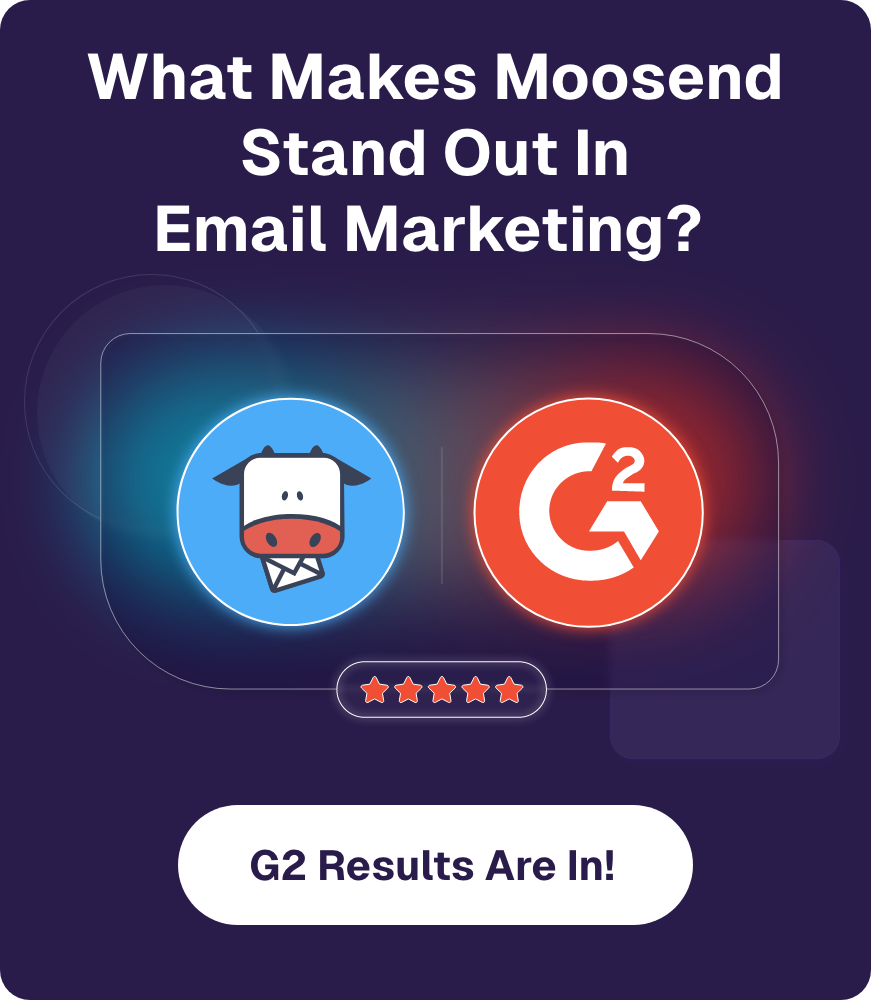

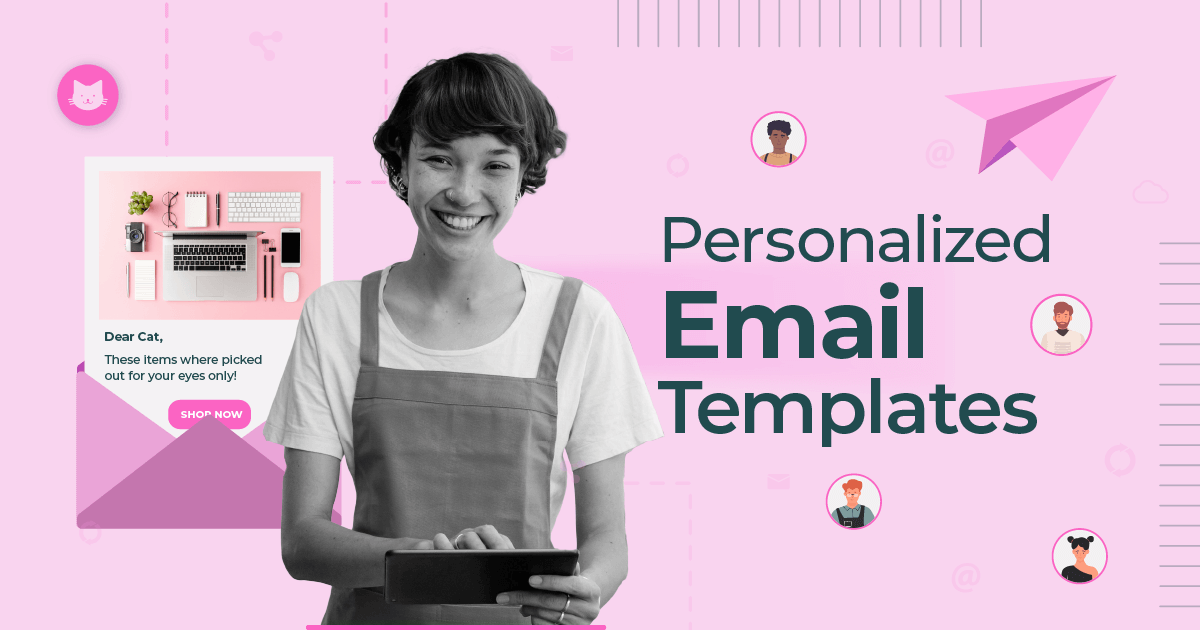
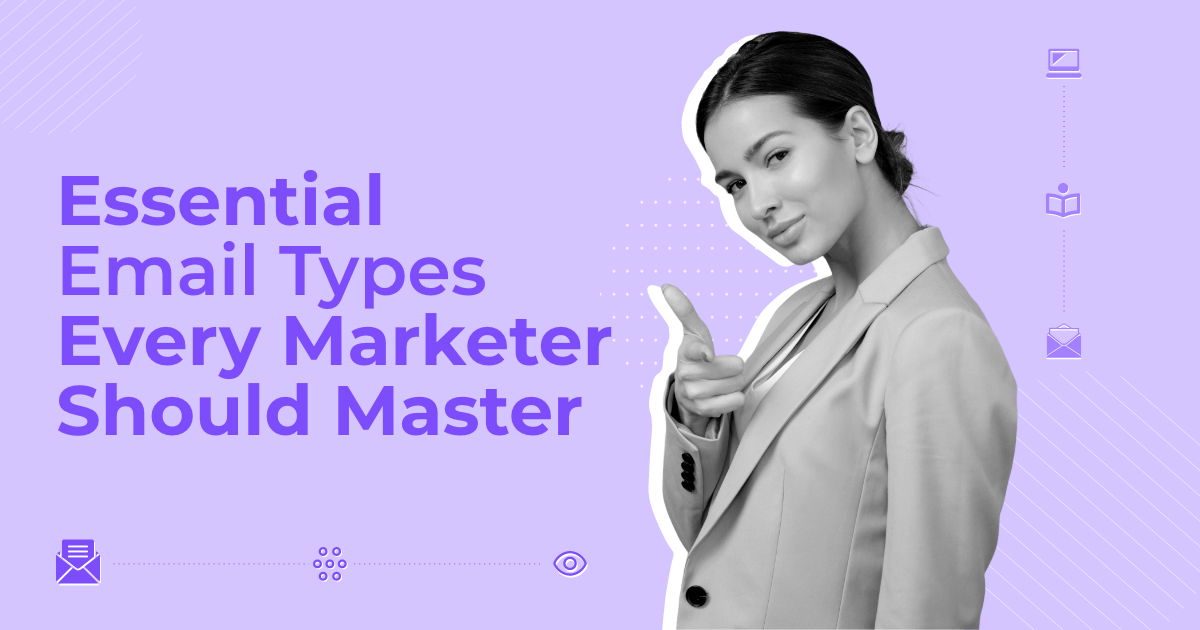
 Published by
Published by
